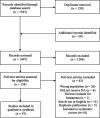Evaluating hemostatic thresholds for neuraxial anesthesia in adults with hemorrhagic disorders and tendencies: A scoping review
- PMID: 33977207
- PMCID: PMC8105160
- DOI: 10.1002/rth2.12491
Evaluating hemostatic thresholds for neuraxial anesthesia in adults with hemorrhagic disorders and tendencies: A scoping review
Abstract
Neuraxial anesthesia can be complicated by spinal or epidural hematoma and may result in permanent neurologic injury. There is a paucity of literature characterizing this serious complication in patients with congenital and acquired hemorrhagic disorders or tendencies. The objective of this scoping review was to describe the hemostatic laboratory parameters where neuraxial anesthesia has been administered with and without spinal and epidural hematoma in patients with preexisting hemorrhagic disorders and tendencies, including immune thrombocytopenia, gestational thrombocytopenia, thrombocytopenia associated with hypertensive disorders of pregnancy, platelet function disorders, von Willebrand disease, coagulation factor deficiencies, and fibrinogen disorders. A systematic search of Ovid MEDLINE, CINAHL, Embase, Scopus, and Web of Science was performed. Two authors independently reviewed all titles, abstracts, and full texts to determine study eligibility and extract data. Qualitative synthesis of 91 studies revealed significant gaps in our understanding of the risk of spinal and epidural hematoma in patients with hemorrhagic disorders and tendencies, including few studies of males and in nonobstetric settings. Most reviewed articles were small, retrospective studies at high risk for potential bias. With such low-quality data, we were unable to provide any true estimates of the risk of spinal or epidural hematoma for these patients, nor could we attribute any specific hemostatic or laboratory values to increased risk of hematoma. There is a need both for larger and more rigorously designed and reported studies on this subject and for structured, comprehensive recommendations for safe administration and removal of neuraxial anesthesia in patients with hemorrhagic disorders and tendencies.
Keywords: anesthesia; blood platelet disorders; epidural; hematologic tests; hematoma; hemorrhagic disorders; spinal.
© 2021 The Authors. Research and Practice in Thrombosis and Haemostasis published by Wiley Periodicals LLC on behalf of International Society on Thrombosis and Haemostasis.
Figures
Similar articles
-
Obstetric neuraxial anesthesia at low platelet counts in the context of immune thrombocytopenia: a systematic review and meta-analysis.Can J Anaesth. 2019 Nov;66(11):1396-1414. doi: 10.1007/s12630-019-01420-w. Epub 2019 Jun 19. Can J Anaesth. 2019. PMID: 31218534 English.
-
What's New in Neuraxial Labor Analgesia.Curr Anesthesiol Rep. 2021;11(3):340-347. doi: 10.1007/s40140-021-00453-6. Epub 2021 Aug 27. Curr Anesthesiol Rep. 2021. PMID: 34466127 Free PMC article. Review.
-
[Spinal and epidural anesthesia in patients with hemorrhagic diathesis : decisions on the brink of minimum evidence?].Anaesthesist. 2011 Dec;60(12):1126-34. doi: 10.1007/s00101-011-1930-z. Epub 2011 Jul 31. Anaesthesist. 2011. PMID: 21805163 Review. German.
-
Neuraxial techniques in obstetric and non-obstetric patients with common bleeding diatheses.Anesth Analg. 2009 Aug;109(2):648-60. doi: 10.1213/ane.0b013e3181ac13d1. Anesth Analg. 2009. PMID: 19608843 Review.
-
Lumbar neuraxial procedures in thrombocytopenic patients across populations: A systematic review and meta-analysis.J Clin Anesth. 2020 May;61:109666. doi: 10.1016/j.jclinane.2019.109666. Epub 2019 Dec 4. J Clin Anesth. 2020. PMID: 31810860
Cited by
-
Hypertriglyceridemia-Induced Acute Pancreatitis in Pregnancy: A Case Report in Anesthetic Management.Cureus. 2024 Sep 21;16(9):e69852. doi: 10.7759/cureus.69852. eCollection 2024 Sep. Cureus. 2024. PMID: 39435233 Free PMC article.
-
Challenges and Strategies in Administering Anesthesia to Pregnant Patients With Malaria: A Comprehensive Review.Cureus. 2024 Aug 20;16(8):e67285. doi: 10.7759/cureus.67285. eCollection 2024 Aug. Cureus. 2024. PMID: 39301349 Free PMC article. Review.
-
Anesthetic considerations for joint replacement surgery in hemophilic arthropathy: a comprehensive review.Anesth Pain Med (Seoul). 2024 Jul;19(3):194-208. doi: 10.17085/apm.24047. Epub 2024 Jul 23. Anesth Pain Med (Seoul). 2024. PMID: 39069647 Free PMC article. Review.
-
A high HEMSTOP bleeding score is a major independent risk factor for postpartum hemorrhage: a prospective cohort study.BMC Pregnancy Childbirth. 2025 Feb 14;25(1):165. doi: 10.1186/s12884-025-07281-0. BMC Pregnancy Childbirth. 2025. PMID: 39953463 Free PMC article.
-
Perioperative management and neuraxial analgesia in women with factor XI deficiency (<60 IU/dL): a French multicenter observational study of 314 pregnancies.Res Pract Thromb Haemost. 2024 May 27;8(4):102462. doi: 10.1016/j.rpth.2024.102462. eCollection 2024 May. Res Pract Thromb Haemost. 2024. PMID: 39006229 Free PMC article.
References
-
- Kreppel D, Antoniadis G, Seeling W. Spinal hematoma: a literature survey with meta‐analysis of 613 patients. Neurosurg Rev. 2003;26:1‐49. - PubMed
-
- Wu CLC, Richman SR, Rowlingson JM, et al. Efficacy of postoperative patient‐controlled and continuous infusion epidural analgesia versus intravenous patient‐controlled analgesia with opioids: a meta‐analysis. Anesthesiology. 2005;103:1079‐1088. - PubMed
Publication types
LinkOut - more resources
Full Text Sources
Other Literature Sources


